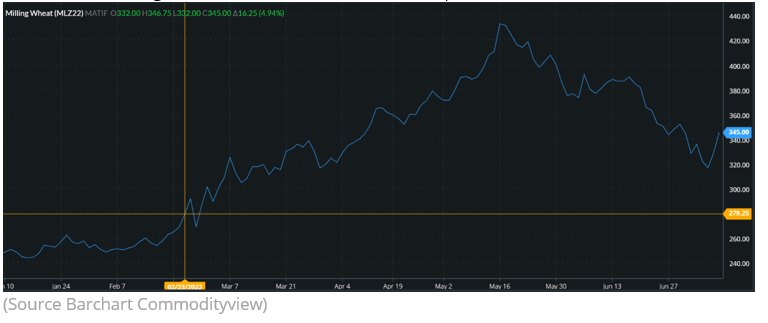Insight Focus
- Wheat market volatility has been off the scale for months
- Maintaining a calm perspective is not always easy
- Managing the effects on your business can be critical
Introduction
In the first six months of 2022 the price of wheat as well as that of many other commodities, currencies and financial indices have been extremely volatile.
In the wheat markets record highs were set following Russia’s invasion of Ukraine in late February.
Despite the war dragging on, prices have tumbled in recent weeks, prompting a stalling rally last week.
Markets have been volatile on a minute-by-minute basis, awaiting the next headline on the war or economic data release.
Whatever your business needs; as a farm producer, trader, user or consumer, managing unprecedented fluctuations to protect your business can be a daunting and difficult task.
Looking at the Volatility
The charts below show how volatility is not a one directional movement over a period of time. Both the bull market from 24th February to 16th May and the subsequent bear market from 17th May have had plenty of ups and downs along the way. As has happened again within the last week.
Chart 1. Chicago Soft Red Wheat Dec ’22 contract (Lines show price on 23rd Feb ’22)

Chart 2. Paris Milling Wheat Dec ’22 contract (Lines show price on 23rd Feb’22)

Adding to the complications of managing risk is the fact that markets have not risen or fallen in equal measure.
As the above charts show, Chicago SRW prices have fallen back to below the levels hit immediately before the February invasion, despite having rebounded a little over recent days.
While others, such as Paris MW, prices have staged only partial retracements lower.
The Difficulties Associated with Turbulent Times
We discussed pricing wheat in volatile times in our Explainer of November last year. Some of the drivers of market turbulence have since changed, but the principles of managing them remain.
‘Hope, Fear & Greed.’ Known as the three biggest downfalls of a trader, they all too often prove, in hindsight, to be the drivers of poor decision making. Avoiding the emotional interference generated by these three pricing demons can be hard but critical.
Facts, the Here & Now. Have the conviction to make calm decisions based upon the facts available at the time. You are only human and cannot see what w ill emerge tomorrow. Do not be afraid to change your view as facts change.
Price Management in Extreme Times
Like many other markets wheat is subject to numerous influencing factors, both fundamental and technical. Trying to second guess the top or bottom of a price move is almost impossible.
Managing the risks means knowing an individual business needs. These will vary, governed by the position of the business in the chain; farm producer, trader, user or consumer.
Fixed Price
Whether a buyer or a seller, wheat price is generally straight forward to fix. If there is a margin that allows a profit for the business it can never be wrong to take it.
Locking in a profit margin and moving on to the next challenge is often an effective use of emotional headspace.
In difficult times, as we have seen so far in 2022, fixing a percentage can prove to be a safe bet. That will leave some for another day to spread the price risk.
Fixing at values that make a profit will, if nothing else, ensure surviving stormy waters to fight another day.
Co-operative Style Pool Pricing
A large number of participants do not have the time or interest to follow markets. They are often more focused on operational matters.
Where market interest or time to study the movements is lacking, a pool style pricing mechanism can be extremely useful.
Companies such as the large grain traders run pool pricing schemes. The focus will be on procuring committed volume that will allow sales of little and often.
The final result returning a relatively average price for the season, avoiding the peaks and troughs, without the distraction of having to follow the market.
An ideal solution for those who feel bewildered or no interest, when looking at the markets.
Options, Minimum or Maximum Price Contracts
Traded in a variety of guises, whether buying puts or calls, physical minimum or maximum price contracts; these are often simpler than people are generally led to believe.
There will be costs involved, which can sometimes be viewed as a negative unless understood.
The principle is that a contact is entered into with a strike price agreed for a defined time in the future.
This allows a buyer to know that the price will never be more, but may be less. While conversely, a seller can rest assured of a price that will not go down, but may go up.
A particularly useful tool in managing the volatility of markets such as we have seen in recent months as long as the costs do not completely erode the entire margin.
Conclusions
For both the bulls and the bears, 2022 is proving quite a challenge for wheat market participants.
Like a rabbit in the headlights, volatile markets can prompt emotionally charged, poor decisions.
Calm consideration of the facts available and ability to reassess is key to good risk management.
Use the best contract mechanism for the individual business. It’s not a one size fits all.
Focus on margin maintenance, be disciplined and remember that ‘profit is sanity’!
Other Insights That May Be of Interest…
Why Demurrage is Bolstering Inflation
Rising Rice Prices Could Signal Winter of Unrest
Other Explainers That May Be of Interest…




